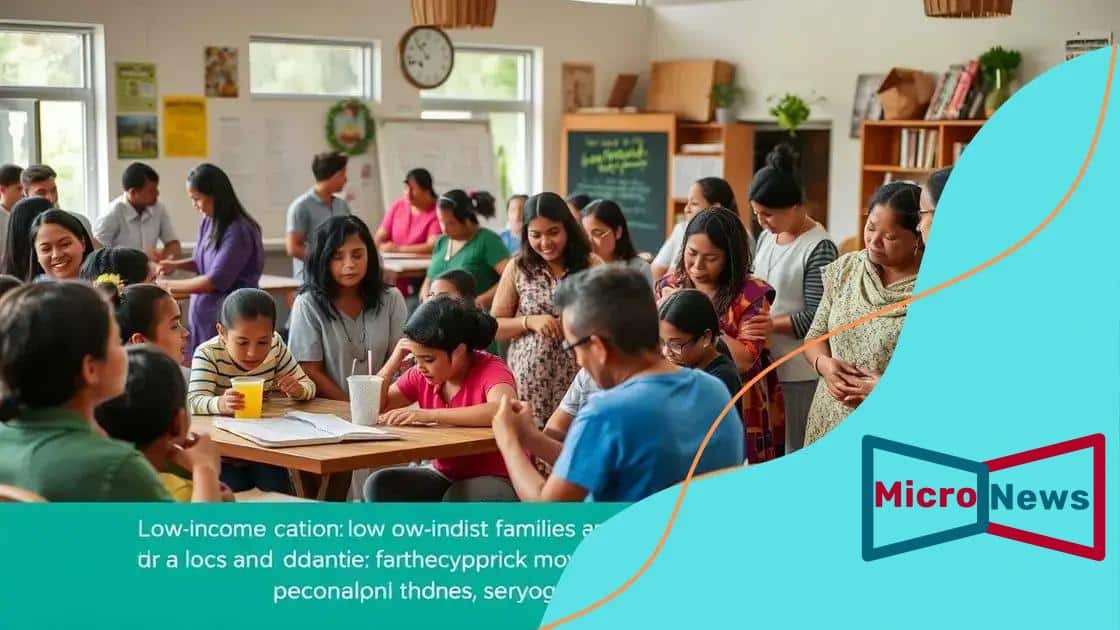Expanding access to affordable housing under new federal policies

Expanding access to affordable housing under new federal policies enhances housing availability, promotes community engagement, and leverages technology to create sustainable solutions for low-income families.
Expanding access to affordable housing under new federal policies is a vital topic for many families today. Have you ever wondered how these changes could affect your housing options? Let’s delve into it.
Understanding the new federal policies
Understanding the new federal policies is crucial for everyone interested in affordable housing. These policies aim to create more opportunities for individuals and families in need. With various changes being implemented, it’s important to be informed.
Key Aspects of the Policies
Several aspects define these new policies. They focus on funding, accessibility, and sustainability. By addressing these areas, the government hopes to make a significant impact.
- Increased funding: More resources allocated to housing projects.
- Streamlined regulations: Simplified processes for developers.
- Environmental considerations: Promoting eco-friendly housing options.
In addition to funding, the policies emphasize collaboration with local communities. This allows neighborhoods to engage actively in the planning process. For instance, residents can voice concerns or suggest features they want in affordable housing developments.
Impact on Local Communities
The approach seeks to strengthen community ties. By involving locals, the resulting housing solutions should better meet their needs. Thus, affordable housing becomes not only a construction project but a community endeavor.
Furthermore, these policies aim to address systemic barriers to housing. They tackle issues such as discrimination and provide better resources for marginalized groups. This holistic view is essential for achieving real change.
The impact on affordable housing availability
The impact on affordable housing availability is significant with new federal policies in place. These changes have the potential to reshape communities and improve living conditions for many families.
Increased Housing Supply
One of the main goals of these policies is to increase the overall supply of affordable housing units. This aims to create more options for families struggling to find suitable places to live. By investing in various housing projects, the government hopes to address urgent needs in the market.
- New constructions: More apartments and homes being built.
- Renovations: Revitalizing existing units to make them livable.
- Partnerships: Collaborating with private developers to boost projects.
Moreover, sustainability efforts play a vital role. The focus on environmentally friendly construction practices not only provides modern housing but also ensures that future generations benefit. Integrating green technologies in affordable housing leads to reduced utility costs for residents.
Accessibility for Vulnerable Populations
Another impact is the improvement in accessibility for vulnerable populations, including low-income families and individuals with disabilities. By implementing policies that prioritize these groups, we can see a shift in who has access to affordable housing.
Furthermore, this initiative can also stabilize rental prices in the surrounding areas. When more affordable options exist, it lessens the burden on renters and helps prevent displacement. In the long run, this contributes to stronger, more resilient communities.
Benefits for low-income families

The benefits for low-income families are significant under the new federal housing policies. These benefits aim to ease the financial burden on families and provide them with better living conditions. With the focus on affordable housing, many families can now access opportunities that were previously out of reach.
Enhanced Financial Stability
One of the primary benefits is enhanced financial stability. Lower rental costs mean that families can allocate more of their income to other essential needs. This financial breathing room allows for investments in education, healthcare, and savings.
- Reduced housing costs: Families can save money each month.
- Increased disposable income: More funds available for groceries and healthcare.
- Opportunities for education: Families can invest in their children’s schooling.
In addition to financial benefits, access to quality housing can improve overall well-being. Living in safer neighborhoods contributes to better physical and mental health. With access to parks, good schools, and healthcare, families thrive in supportive environments.
Community Support and Resources
Moreover, affordable housing initiatives often come with community support resources. Many programs provide services such as job training, financial literacy workshops, and healthcare access. These resources empower families to achieve long-term goals and break cycles of poverty.
With a focus on collaboration, local organizations often partner to offer services that enhance the community’s overall quality of life. This approach creates a strong network of support for families, allowing them to feel more connected and engaged in their neighborhoods.
Community engagement in housing initiatives
Community engagement in housing initiatives plays a vital role in shaping successful projects. When communities participate in the planning and development processes, the results are often more aligned with their needs and preferences. This kind of engagement helps foster a sense of ownership and belonging.
Benefits of Community Involvement
Involving the community brings numerous benefits to housing initiatives. First, it encourages collaboration between residents, local governments, and developers. This collaborative effort ensures that the voices of those affected are heard, leading to better decision-making.
- Tailored solutions: Housing projects can be adjusted based on community feedback.
- Stronger connections: Residents build relationships with one another.
- Shared responsibility: Communities take pride in their developments and invest in their upkeep.
Furthermore, community engagement creates transparency in housing initiatives. When residents are informed and involved, they feel more confident in the processes driving their neighborhoods. This results in a more trusting relationship with local government and developers, leading to smoother project execution.
Methods of Engagement
Various methods can be employed to encourage community engagement. Public meetings and workshops allow residents to express their opinions and contribute ideas. Surveys and questionnaires can gather diverse input efficiently, providing valuable insights into community needs.
Additionally, partnerships with local organizations can help promote housing initiatives. By collaborating with groups that already serve the community, housing projects can reach a broader audience and create inclusive solutions that benefit everyone.
Future outlook for affordable housing solutions
The future outlook for affordable housing solutions is promising as new policies emerge. With a growing focus on sustainability and community involvement, these solutions are set to evolve significantly in the coming years. The integration of innovative strategies will address current challenges in the housing market.
Trends Shaping the Future
Several trends are shaping the future of affordable housing. One major trend is the use of technology in construction and management. Technologies like 3D printing and modular building methods can reduce costs and construction times. This shift will enable more units to be built swiftly, thereby meeting urgent housing needs.
- Smart homes: Incorporating technologies that enhance energy efficiency.
- Eco-friendly materials: Using sustainable resources to build homes.
- Data analytics: Applying data to understand housing demand better and manage resources efficiently.
Another trend is the commitment to inclusivity. Future housing initiatives are expected to prioritize diverse needs, including those of low-income families and individuals with disabilities. By focusing on accessibility, communities will become stronger and more resilient.
Role of Government and Private Sector
The collaboration between government and private sectors will be crucial in the upcoming years. Governments will continue to create frameworks that facilitate affordable housing development. Meanwhile, private companies can bring innovation, efficiency, and investment to the table.
Moreover, public-private partnerships can lead to creative solutions that benefit both developers and communities. By working together, they can tackle complex issues like zoning laws and funding challenges, paving the way for more inclusive housing developments.
FAQ – Frequently Asked Questions about Affordable Housing Solutions
What are the main benefits of the new federal housing policies?
The new federal housing policies aim to increase the availability of affordable housing, enhance financial stability for families, and promote community involvement in housing initiatives.
How can community engagement improve housing projects?
Community engagement allows residents to voice their needs and preferences, leading to housing solutions that are better tailored to their specific requirements.
What role does technology play in affordable housing?
Technology can streamline construction processes, reduce costs, and introduce energy-efficient designs that improve the sustainability of new housing developments.
How can private and public sectors collaborate on housing solutions?
Public-private partnerships can combine resources, expertise, and innovation, tackling challenges like funding and regulatory issues to create effective housing solutions.





